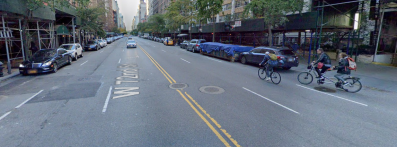Two-Way Bike Lane Will Cross Central Park Along 72nd Street

This summer, cyclists will have a second path to safely cross Central Park.
At a meeting of CB 7’s Parks Committee last night, Central Park Conservancy President Doug Blonsky announced that the Department of Transportation will paint a new two-way bike lane along 72nd Street all the way between Central Park West and Fifth Avenue, reducing the number of motor vehicle lanes on that stretch of the park road from two to one.
Unlike the new cross-park bike route near 96th Street, this one won’t be a shared path for cyclists and pedestrians, nor will it include dismount zones at either end of the park. Blonsky said the redesign should be in place by June.
“This is a significant step both toward making crossing the park on a bicycle less perilous and toward a car-free park in general,” said Manhattan Community Board 7 member and car-free Central Park advocate Ken Coughlin. “For the first time, cyclists will legally be able to traverse the entire park without walking their bikes at any point or risking their lives on the sunken transverses.”
At the meeting last night, Blonsky said that reviews of the designated bike route along 96th Street have been positive so far, but that no additional crosstown bike paths through the park are planned until the Conservancy has more time to observe the first two, according to Coughlin. Previously, the Conservancy floated plans for additional cross-park paths at 102nd Street and 86th Street.
The removal of a traffic lane from 72nd Street, which is open to cars during rush hour, marks another step in the incremental reclamation of Central Park from motor vehicles. “The fact that non-motorized transportation now has priority on a park road bodes well for a return to the true urban refuge the park’s designers envisioned and created,” said Coughlin.
Last year, several community boards surrounding the park and the Manhattan Borough Board voted in favor of a summer car-free trial. In response, the Bloomberg administration apparently began to measure traffic volumes on the park road so the effect of a trial can be quantified.

